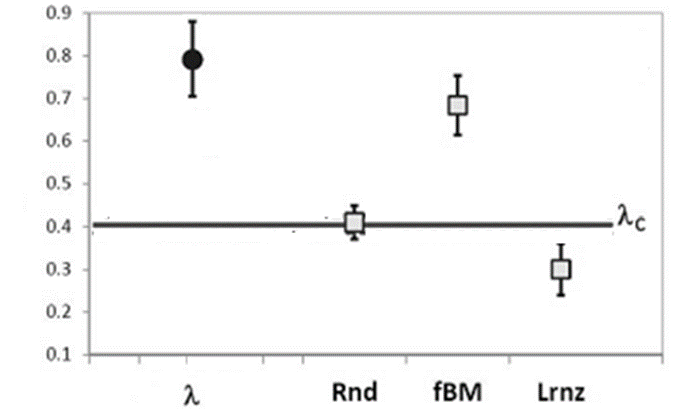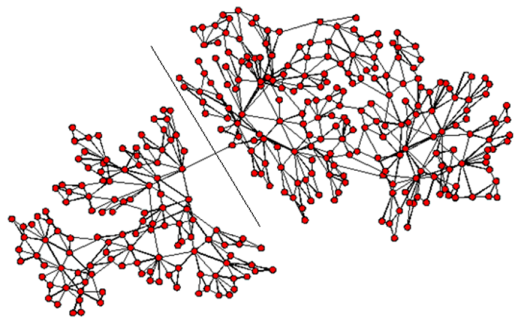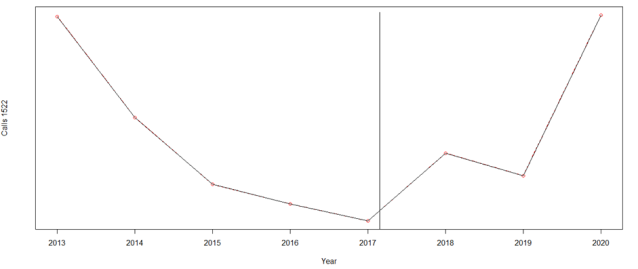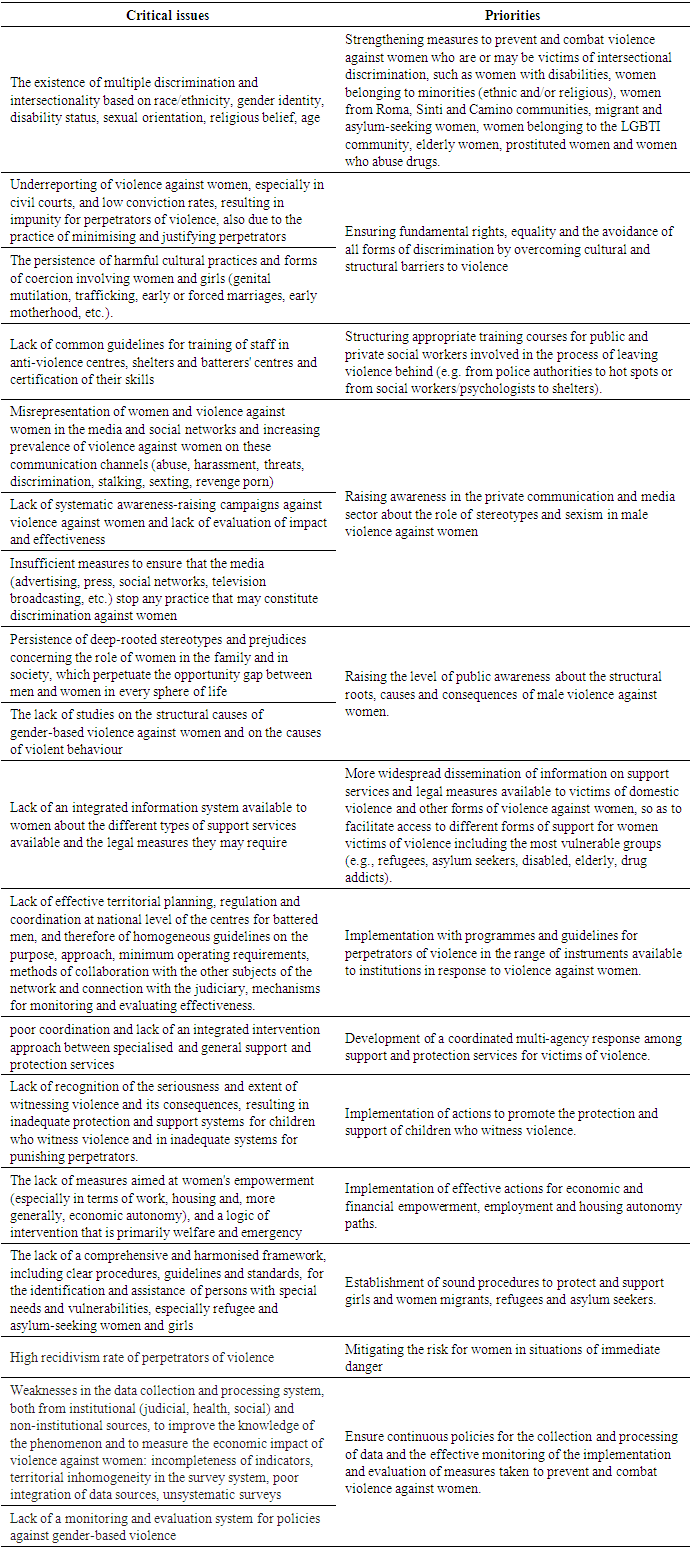-
Paper Information
- Paper Submission
-
Journal Information
- About This Journal
- Editorial Board
- Current Issue
- Archive
- Author Guidelines
- Contact Us
International Journal of Statistics and Applications
p-ISSN: 2168-5193 e-ISSN: 2168-5215
2022; 12(2): 23-29
doi:10.5923/j.statistics.20221202.01
Received: Jan. 12, 2022; Accepted: Feb. 16, 2022; Published: Feb. 24, 2022

Violence Against Women in Italy: Understanding the Recent Dynamics after the Impact of Istanbul Convention
1University “Niccolò Cusano”, Rome, Italy
2Department of Education Sciences, University of Roma Tre, Rome, Italy
Correspondence to: Luca Rossi, University “Niccolò Cusano”, Rome, Italy.
| Email: |  |
Copyright © 2022 The Author(s). Published by Scientific & Academic Publishing.
This work is licensed under the Creative Commons Attribution International License (CC BY).
http://creativecommons.org/licenses/by/4.0/

Reports of violence against women in Italy have increased significantly over the past decade, with a surge in 2019. The aim of this work is to understand the changes this phenomenon is having in Italy and whether these changes are related to the policies implemented by the Italian Government. For this purpose, we have applied the social network analysis to the historical series provided by ISTAT regarding reports of violence against women. The analysis, in the evolution of the phenomenon, highlights two different historical periods, characterized by different dynamics. The transition coincides with the impact of the application of the Istanbul Convention in Italy through the implementation of two anti-violence plans.
Keywords: Violence against women, Women population dynamics, Social network analysis, Public policy impact
Cite this paper: Luca Rossi, Chiara Carbone, Violence Against Women in Italy: Understanding the Recent Dynamics after the Impact of Istanbul Convention, International Journal of Statistics and Applications, Vol. 12 No. 2, 2022, pp. 23-29. doi: 10.5923/j.statistics.20221202.01.
1. Introduction
- To understand how the phenomenon of violence against women is continuously changing in Italy, it is necessary to reflect on the connection between changes in the attitude of the female population to disclose the situation of violence and the public policies adopted and implemented by the Ministry of gender equality. At the beginning of our work we asked ourselves: why did calls to 1522 (a public service, promoted by the Presidency of the Council of Ministers - Department of Equal Opportunities, activated in 2006 with the aim of combating the phenomenon of intra and extra-family violence) increase from 2013 to 2020, especially with a surge in 2019? What has impacted on the habits of the female population and on the way they use the anti-violence number? Certainly the increase from March 2020 to October 2020 can be attributed to the pandemic situation: women were forced to stay at home with their abuser and this increased stress, risk and violence. But what other more structural and long-term reasons impacted on the increase in calls? This article, using a Social Network analysis, analyses the changes in the use of the anti-violence public utility number 1522 from 2013 to 2020. The results highlight an increase in calls that, in Italy, can be contextualised in a series of public policies put in place to implement the principles of the Istanbul Convention (2011). The rest of the paper is organised in the following way. In the second section, we list the legislative context and the public policies implemented to applied the principles and the legislative framework in the Italian context. In the third section, we introduce the statistical methodology applied to data collected by National Institute of Statistics. Then, we discuss the main results in the fourth section. Finally, the fifth section provide the discussion and conclusion of our study.
2. The legislative Framework
- In outlining a legislative framework on violence against women, it is worth mentioning the Council of Europe Convention on preventing and fighting violence against women and domestic violence' (adopted in Istanbul on 11 May 2011 and ratified by Italy with law no. 77 of 27 June 2013). This is of particular relevance, indeed it plays a key role in the organisation of national policies on handling all forms of violence against women. The two main instruments to implement the Istanbul Convention in Italy have been two Anti-Violence Plans (2015-2017 and 2017-2020) of which the National Research Council is in charge of evaluating the interventions. The intervention strategy of the two Plans is primarily aimed at pursuing the objectives indicated in the Convention promoted by the Council of Europe on preventing and combating violence against women and domestic violence adopted in Istanbul on 11 May 2011 (known for this reason as the 'Istanbul Convention') and entered into force on 1 August 2014 following Italy's ratification (by Law No. 77 of 27 June 2013). This is the first legally binding international instrument that proposes a comprehensive and integrated legal framework to protect women against all forms of violence. In order to promptly implement some of the measures provided for by the aforementioned Convention, during the session of the Council of Ministers of 8 August 2013, Law Decree No. 93 of 14 August 2013 was approved, containing "Urgent provisions on security and for combating gender-based violence, as well as on civil protection and the commissioning of provinces", containing, among other things, measures aimed at strengthening both the protection, including criminal protection, of women victims of violence and at preventing the phenomenon of gender-based violence. The measure, subsequently converted with amendments by Law no. 119 of 15 October 2013, updated and reshaped the instruments for preventing and suppressing gender-based violence, also domestic violence. In order to define a comprehensive intervention strategy, Article 5 of the same law provides for the adoption of an extraordinary Action Plan against sexual and gender-based violence. Moreover, in order to strengthen the relief and assistance structures for victims, it introduced a specific article (Art. 5 bis). The 'Extraordinary Action Plan against Sexual and Gender-based Violence' represents, therefore, the first attempt to make operational a system of public policies consistent with the principles laid down by the Istanbul Convention and supplementing, from the point of view of interventions, the criminal provisions contained in the above-mentioned law. The two-year Plan was adopted by Decree of the President of the Council of Ministers of 7 July 2015 and registered by the Court of Auditors on 25 August 2015. Subsequently, during the meeting of the Council of Ministers on 23 November 2017, also in order to give continuity and further development to the interventions implemented in the previous three-year period, the Government approved a new National Strategic Plan on Male Violence against Women 2017-2020, with a three-year duration. This document defines an intervention strategy characterised by a logic of partnership and integrated policies, providing for the accountability of all those who are called upon to implement it. The strategic lines of the new plan were drawn up by a special working group set up ad hoc in agreement with representatives of the central, regional and local administrations and the relevant associations, together with the major trade unions. In line with the framework of the Istanbul Convention, the first anti-violence plan (2015-2017) represents the operational translation of the political awareness of the persistence and danger of male violence against women in Italy. Furthermore, it highlights the connection that exists between discrimination and violence in a social model where the construction of roles still corresponds to the real power relations between men and women. In particular, violence against women is considered as a violation of human rights (as established for the first time in the European Union in 1992 by CEDAW Recommendation No. 195) as well as a form of discrimination that severely inhibits women's ability to enjoy rights and freedoms on an equal basis with men. In this regard, it is recalled that violence against women is a manifestation of the historical, cultural and social inequality between genders. This inequality takes the form of multiple forms of inequality and discrimination that affect women and their social relations in different contexts.The plan therefore proposes a holistic and multilevel approach to gender-based violence, combining the necessary measures to punish perpetrators and support victims - not only to provide relief but also empowerment – aiming at changing collective conceptions of the role of women, still strongly anchored to traditional and stereotypical models, either symbolically and materially. From this framework, four levels of intervention are derived: • Preventive, with the aim of promoting a change in attitudes, gender roles and stereotypes that make male violence against women acceptable.• Protective, for the implementation of measures that protect and support women and their daughters in the individual project of emancipation from the state of vulnerability that violence determines.• Punitive, for the effective prosecution of crimes committed in the context of gender-based violence.• Assistance and Promotion to collect properly data and to develop an evaluating and monitoring system to study the phenomenon of violence against women.The second tool, the Strategic Plan 2017-20207 proposes the four strategic axes of the Istanbul Convention, already mentioned above. The Operational Plan 2017-2020 further defined the priorities for action, the target population and the cross-sectoral nature of the interventions, particularly in relation to the strategic commitment of the various ministries in their areas of competence. The strategic commitment of the various ministries in their areas of competence also aims at approaching the phenomenon of violence against women in a cross-sectoral and integrated way, thus acting through the definition of multi-level policies. In particular, it also adds: a transversal Axis of support for the implementation of integrated policies, the construction of an integrated data collection system and the and monitoring and evaluation activities. In addition, throughout the Plan there is also a specific focus – absent in the previous plan - that, transversal to the different axes, identifies migrant women, refugees and asylum seekers as the target of intervention. To better focus on our analysis it’s important to deeply describe some critical issue and related priorities to achieve of both plans:
|
3. Methodology
- The social network analysis (SNA) is one of the important quantitative techniques in the process of effective decision-making process that uses graphical approach to represent relationships.Network analysis provides the capacity to estimate complex patterns of relationships and the network structure can be analysed to reveal core features of the network.For analytical purposes, a SNA can be seen as a graph and the aim is to provide direct mapping of ties showing their clustering as well as scatterdness. In a graph a variable can be a vertex or a node. A tie between two node indicates the presence of the relationship connecting them. Absence of a tie indicates absence of relationship. The size of the lines (edges) vary to reflect the varying strength of relationship between the variables. Networks can be described as being directed (i.e. all edges are directed) or undirected (i.e. no edges are directed). Directed networks can represent causal structures. The network visually represents the pattern of relationships between variables and a network can be estimated using common statistical parameters that quantify relationships, e.g. correlations, covariances, partial correlations, regression coefficients, odds ratios, factor loadings (Scott, 1988).The aim of this work is to investigate if the Istanbul convention and its ratification in Italy by the law n. 77 (Ratifica ed esecuzione della Convenzione del Consiglio d'Europa sulla prevenzione e la lotta contro la violenza nei confronti delle donne e la violenza domestica, fatta a Istanbul l'11 maggio 2011) and the actions and priorities implemented by the two anti-violence plans in favour of women victims of violence, push more and more women to break the silence and denounce the abuses they are suffering. We wonder if there is any connection between applied policies and priorities to the self determination of women in terms of increase of help and support requests.SNA is used to analyse the dynamics of violence against women in Italy for the period 2013-2020. At this aim the Horizontal Visibility Graph (HVG) algorithm is necessary (Bezsudnov et al., 2014). The idea is to transform a time series of N observations into a Network of N nodes on which the SNA can be applied to understand and evaluate the changes in the phenomenon under consideration. The HVG is a geometric criterion for mapping an ordered series, for instance a temporal series of N real valued data ({x(t)} t ∈ [1; N]) into a graph of N nodes, in particular two nodes j and k are linked by an undirected edge if the associated data x(j) and x(k) have horizontal visibility and so every intermediate datum x(i) satisfies the relationship:x(i)<inf{x(j), x(k)}, ∀ i∈[j,k]Following the algorithm, the numeric values of time series (fig. 1a) are the network nodes and are first represented in a bar chart (fig. 1b). The links are drawn considering the visibility criteria (fig. 1c). Once the nodes and the links determined describe univocally the undirected network graph (fig. 1d).
 | Figure 1. Steps of HVG algorithm |
4. Results
- In this work, we used the data provided by National Institute of Statistics ISTAT on telephone calls or messages received to the public utility number 1522 in the period 2013-2020 considering the months between March and October to investigate the effects that various legislative measures and the given support to the anti-violence centres have arisen or are rising over women who are victims of violence. The HVG algorithm is used to transform the time series considered into a network then studied applying SNA.The statistical distribution of the nodal connection of network, obtained with HVG algorithm, allowed us to verify the complexity of the phenomena considered. The figure 2 showed that nodal distribution follows an exponential distribution, highlighting the complexity of dynamics of the system considered. The value of exponent of nodal distribution (λ=0.809) is higher than critical value (λc=0.405).
 | Figure 2. Degree distribution for violence against women |
 | Figure 3. Comparison of degree exponents with other models |
 | Figure 4. Social network graph |
 | Figure 5. Trend of time series |
5. Conclusions
- This paper aimed at investigating the connection between changes in the attitude of the female population to disclose the situation of violence and the public policies adopted and implemented by the Ministry of gender equality. Furthermore, the evolution of the phenomenon of violence against women in Italy has been analysed. The real nature of phenomenon is measured with the use of the HVG algorithm, which highlightedthe complexity of the problem characterized by an exponential nodal distribution (degree distribution). From an analytical point of view, this information should push researchers and professionals to abandon performance measurement systems anchored to past operational values and criteria in favour of non-linear indices to measure the intensity of the phenomenon. Furthermore, the complexity is certainly due to some relevant political choices. The results obtained through SNA brought us to discover a structure for phenomenon composed by two communities (modules) corresponding to major changes in the basic dynamics of the system in the years 1016/2017. The transition coincides with the impact of the Istanbul Convention application in Italy by two Anti-violence Plans.In fact, these were the main tools by which, in a national and social level, the actions had an impact on women’s awareness The change of attitudes can be measured through the implementation of the data systematisation of The National Institute of Statistics and the Department for Equal Opportunities of the Presidency of the Council of Ministers that made available an integrated information framework on violence against women in Italy. The aim is to provide quality information and indicators that allow an overall view of this phenomenon, through the integration of data from various sources such as ISTAT, the Department for Equal Opportunities, Ministries, Regions, Anti-Violence Centres, Shelter Homes and other services such as the public utility number 1522. Documents on Italian and European policies against violence, prevention, training activities in schools and among operators, as well as statistical and analytical reports are made available. The system derives from the National Plan against Violence against Women and wants to be a privileged observatory to allow government bodies and all public and private actors involved in combating gender-based violence to monitor the different aspects of the phenomenon and fight it with adequate means in order to achieve the objectives of the Istanbul Convention. All these measures implemented between 2017 and 2020 have led to a concrete change in the perception of the situation of violence and in fact the campaigns against violence against women and the re-launch of 1522 have triggered changes in the use of the public service number. The increase in awareness triggered by the awareness-raising campaigns and the actions taken with funding to support anti-violence centres, shelters and all those projects that have been financed in various ways by public funding from the Equal Opportunities Department, have generated a humus for social change that can be seen in the increases in the use of 1522 since the beginning of the year. Of course, if we look at 2020 we realise that phone calls from the end of March to October had an increasing increase, due to the lock down which meant for many women the beginning of a period of forceful violence. #Stayinghome meant sharing daily space with the abuser and consequently led to an increase of violent situations and calls registered to 1522. However, using the model presented beyond covid-19, it can be argued that the impact of the policies and the implementation of the Istanbul Convention has generated a change in the attitudes of women who are more likely to contact 1522, the national anti-violence number.The main directions that must be taken to combat violence against women are and remain those identified in the Istanbul Convention on the prevention and protection of victims. To these activities must always be added the repressive action against the guilty. The real difficulty is to consider these aspects at the same time. We can do this by building a complex response through an integrated approach, starting from the awareness that stricter sanctions already exist and unfortunately are not enough, that it is not enough to “shout emergency”. It is essential to break down, through education, knowledge and training, stereotypes and prejudices rooted and still too widespread in our society.
 Abstract
Abstract Reference
Reference Full-Text PDF
Full-Text PDF Full-text HTML
Full-text HTML